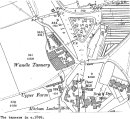These works were situated just northwest of Goat Bridge, Beddington Corner, on the west side of Watermeads Lane. The Wandle now runs beside the east side of the lane, in an artificial channel built in 1964-65. Prior to this the course of the river was farther to the east, in an earlier artificial channel constructed in about 1702 by Richard Bond, then the occupier of a logwood mill farther downstream. Bond's "cut" superseded the original course which ran some distance to the west of it. After the new cut was constructed, that part of the old river that ran on the west side of the tannery site was abandoned, and eventually filled in.
There are two implications of all this relevant to the tannery. First, that the works were not on the river bank, and had no water wheel, although the processes carried on required much water, which was presumably pumped up from the new cut. And secondly, that the boundary between the parishes of Carshalton and Mitcham originally followed the course of the old river to the west of the works, which were therefore originally in Mitcham. The boundary was altered here to follow the course of the new cut, probably in the late 1840s, which brought the tannery within Carshalton.
The earliest reference found to a works on this site is in the book of reference to the Mitcham Tithe Map of 1846, wherein the premises are described as fellmonger's buildings, yard, etc., occupied by Peter Pharoah. He had previously worked at the leather mill in Carshalton a short distance upstream, until about 1840, so it seems likely that he established the tannery after leaving the leather mill. The site of the works was then owned by William Simpson, who had married Emily Cranmer in 1818. She had inherited the Cranmer estates after the death of her brother Richard Cranmer in 1828.
 |
The tannary C 1895 [56kb] |
This "Mr. M'Crae" was probably James McRae, the son of William McRae who had succeeded Peter Pharoah at the leather mill upstream. Together with his cousin John McRae he was named in directory entries from 1860 to 1870. In the 1871 Mitcham census returns James McRae was described as a tanner employing 88 men and 17 boys. James McRae and George McRae, probably his brother, were named as the occupiers in 1872. George McRae and Thomas Alexander & Son were there from 1874 until 1876, and thereafter until 1882 the works were managed by George McRae alone.
By 1887 George Gibbs & Sons were the occupiers. In the 1891 Beddington census Herbert Gibbs, probably a son of George, was named as a leather manufacturer. He died in January 1914, and was succeeded by Henry Gibbs. In fact the firm's name had become Henry Gibbs & Son by 1911. By 1915 they were making only parchment. They were last recorded in 1935.
|
|
|
|